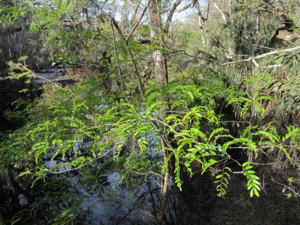Water Gleditschie
| Water Gleditschie | ||||||||||||
|---|---|---|---|---|---|---|---|---|---|---|---|---|

Water Gleditschia ( Gleditsia aquatica ) |
||||||||||||
| Systematics | ||||||||||||
|
||||||||||||
| Scientific name | ||||||||||||
| Gleditsia aquatica | ||||||||||||
| Marshall |
The water-Gleditschie ( Gleditsia aquatica ) is a plant from the genus of honey locusts ( Gleditsia ) in the subfamily of caesalpinioideae (Caesalpinioideae). The natural range of the species is in eastern North America .
description
Vegetative characteristics
The water gleditschia grows as a tree with a height of 15 to 20 meters with a trunk diameter of 0.6 to 0.9 meters. It reaches its greatest height in the lower valley of the Mississippi River . The short trunk is usually divided just above the ground. The bark is thin, firm and covered with small, corky outgrowths; from time to time the bark can also be scaly. Sometimes large, branched thorns appear . The leaves are pinnate in single to double pairs and show a "sleeping position".
Generative characteristics
In contrast to the other Gleditsia species, the legume of the water gleditschia is only around 4 centimeters long and contains one or two seeds without “ pulp ”.
Occurrence
Gleditsia aquatica is common in eastern North America. The water gleditschia thrives in wet locations, such as long-flooded river banks. It often occurs together with the American plane tree ( Platanus occidentalis ), the pointed-leaved adelie ( Forestiera acuminata ), the water elm ( Planera aquatica ), the bald cypress ( Taxodium distichum ), Tupelo plants (Nyssoideae) and various willow species ( Salix ).
Web links
Individual evidence
- ^ A b c Klaus Ulrich Leistikow: The Woodbook: The Complete Plates . TASCHEN Verlag, Cologne 2013, ISBN 978-3-8365-3603-5 , pp. 350 .


